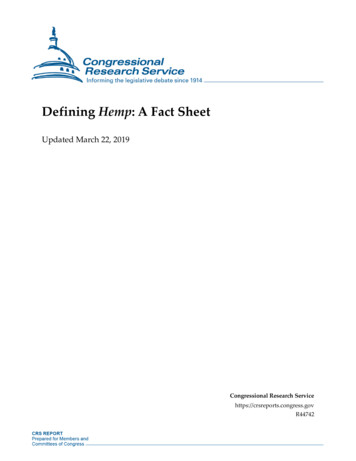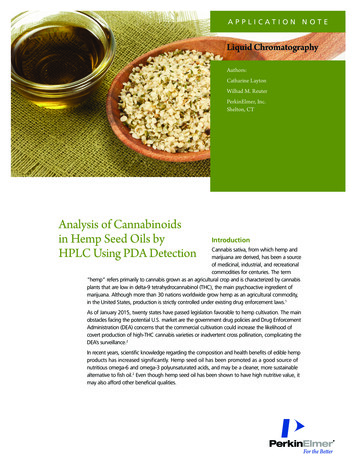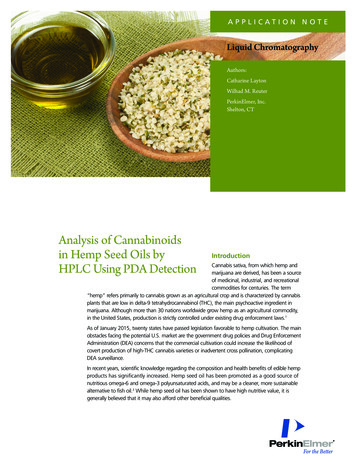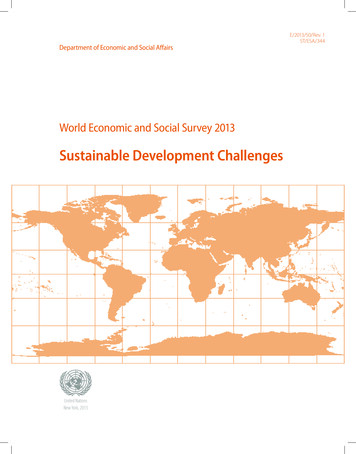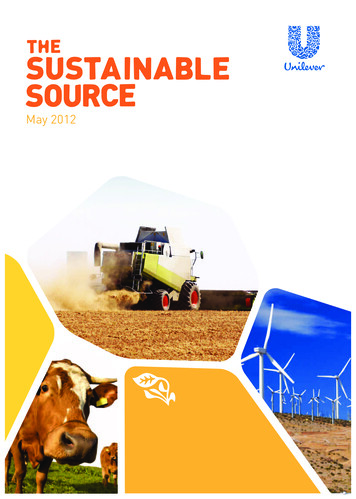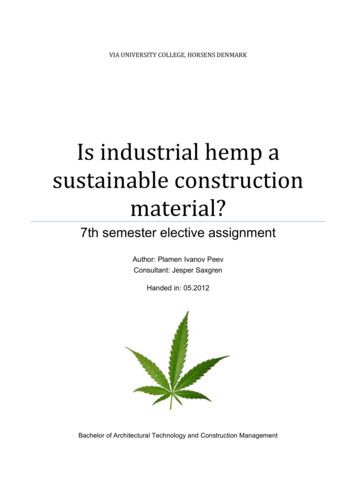
Transcription
VIA UNIVERSITY COLLEGE, HORSENS DENMARKIs industrial hemp asustainable constructionmaterial?7th semester elective assignmentAuthor: Plamen Ivanov PeevConsultant: Jesper SaxgrenHanded in: 05.2012Bachelor of Architectural Technology and Construction Management
Is industrial hemp a sustainable construction material?May 2012IS HEMP A SUSTAINABLE CONSTRUCTION MATERIAL 2012 Plamen Ivanov PeevConsultant: Jesper SaxgrenMay 2012VIA University College, Horsens, Denmark1 Copy, Font: Arial, Abstract font: Times New Roman, Font size: 11, Line spacing: 1.15Number of pages: 36, Number of characters with spaces: 72,846All rights reserved – no part of this publication may be reproduced without the prior permission ofthe author.NOTE: This report was compiled as a compulsory assignment in the 7th semester ArchitecturalTechnology and Construction Management degree course – no responsibility is taken for anyadvice, instruction or conclusion given within!‐1‐
Is industrial hemp a sustainable construction material?May 2012AcknowledgementsI would like to express my gratitude to my dear friend Stanislav who introduced to methe topic of industrial hemp in the building industry. This report wouldn’t be possible without hishelp.‐2‐
Is industrial hemp a sustainable construction material?May 2012AbstractThis report was written as an elective study assignment in the 7th semester Constructingarchitect degree course. My work is a response to the environmental problems we face today and the stepswe take to reduce the environmental impact done by the building industry.This report reflects my investigation weather industrial hemp is a sustainable building materialby evaluating its whole life cycle. My report includes a definition of what a sustainable construction materialis from environmental perspective. This report does not include financial assessment of hemp productiondue the lack of established hemp market and due to the irrelevance of the matter from environmentalperspective. Another goal of this study is to give advice on how to produce hemp building material moresustainably.Chapter 2 and 3 contain empirical data gathered by a secondary research. The informationconcerns hemp production, hemp construction materials such as hempcrete and hemp insulation, and otherpotential uses of hemp. Investigation on their performance as construction materials is evaluated on the basisof my definition for sustainable material in Chapter 1. Traditional materials with similar purpose to hempmaterials are often used for comparison.I believe that my studies in hemp as a construction material are consistent enough and answerthe researched problem questions. I would like to emphasize on the point that my investigation shows thathemp and hemp products are a good way of reducing global carbon emissions and limiting deforestation.Key words: hemp, fiber, crop, hempcrete, clay, lime, insulation, carbon, sustainable, eco, green, CO2,building, environment, recycle, breathable‐3‐
Is industrial hemp a sustainable construction material?May 2012ContentsAcknowledgements . ‐ 2 ‐Abstract . ‐ 3 ‐Contents . ‐ 4 ‐List of illustrations . ‐ 6 ‐Introduction and problem background . ‐ 8 ‐Chapter 1: What is a sustainable construction material? . ‐ 9 ‐Chapter 2: What is hemp and how is it produced? . ‐ 12 ‐2.1 Hemp and Marijuana . ‐ 12 ‐2.2 Growing Conditions . ‐ 13 ‐2.3 Growth and structure . ‐ 13 ‐2.4 Nitrogen and Hemp . ‐ 15 ‐2.5 Pests and diseases . ‐ 15 ‐2.6 Harvesting for fibers . ‐ 16 ‐2.7 Hemp retting . ‐ 17 ‐2.8 Baling and storage . ‐ 17 ‐2.9 Fiber separation . ‐ 18 ‐2.10 Hemp, carbon and embodied energy . ‐ 19 ‐2.11 Conclusions on question 2:‘What is hemp and how is it produced?’ . ‐ 19 ‐Chapter 3: What is the application of hemp as a construction material? . ‐ 21 ‐3.1 General usage of Hemp before and now . ‐ 21 ‐3.2 Hemp‐lime Hempcrete . ‐ 22 ‐3.2.1 Hemp‐lime mixture . ‐ 22 ‐3.2.2 Casting hempcrete walls. ‐ 22 ‐3.2.3 Breathability . ‐ 23 ‐3.2.4 Thermal performance and heat loss . ‐ 23 ‐3.2.5 Acoustics . ‐ 25 ‐3.2.6 Fire resistance . ‐ 25 ‐3.2.7 Carbon emissions . ‐ 25 ‐3.2.8 Lime in hempcrete . ‐ 25 ‐‐4‐
Is industrial hemp a sustainable construction material?May 20123.2.9 Recycling . ‐ 26 ‐3.3 Hemp‐clay Hempcrete . ‐ 26 ‐3.3.1 Properties of clay . ‐ 27 ‐3.3.2 Hemp‐clay mixture . ‐ 27 ‐3.3.3 Clay hempcrete performance . ‐ 27 ‐3.4 Hemp fiber insulation . ‐ 29 ‐3.4.1 Energy demands and traditional insulation products . ‐ 29 ‐3.4.2 Hemp insulation batts . ‐ 29 ‐3.5 Other potential uses of hemp in construction . ‐ 30 ‐3.5.1 Fiberboard . ‐ 30 ‐3.5.2 Hemp plastic . ‐ 31 ‐3.6 Conclusions on question 3: ‘What is the application of hemp as a construction material?’ . ‐ 31 ‐Conclusion . ‐ 33 ‐References . ‐ 35 ‐‐5‐
Is industrial hemp a sustainable construction material?May 2012List of illustrationsFigure 1: ‘The realized necessity of going 'green'’- page 9 e 2: ‘Cannabis Sativa L ’- page 12- tmlFigure 3: ‘Appropriate climate conditions for growing hemp ‘- page 13 .svgFigure 4: ‘Structure of different types of Cannabis Sativa.’- page 14 tmlFigure 5: ‘Harvesting hemp with modern machinery’- page 16 http://www.stextile.com/homepage.htmFigure 6: ‘Harvesting hemp by hand’- page 16 /Figure 7: ‘Hemp field retting’- page 17 - hempfield-rettingFigure 8: ‘Hemp bales storage’- page 18- re 9: ‘Primitive method of breaking dry hemp stalks’- page 18 http://www.hempfood.com/iha/iha04117.htmlFigure 10: ‘Cannabis uses’- page 20 - tmlFigure 11: ‘Hemp-lime mixture’- page 21 - re 12: ‘Casting Hempcrete on sections with plastic shutter forms’- page 22 vice/marianne-suhr/hemcrete-insulationFigure 13: ’Hempcrete wall structure’- 23 http://gse.cat.org.uk/public downloads/research/Ranyl Rhydwen thesis january 2006.pdfFigure 14: ‘Performance of different wall sections during sudden drop of outside temperature ’page 24 - http://gse.cat.org.uk/public downloads/research/hemp/Neal Holcroft.pdfFigure 15: ’Window bottom frame standing directly on the hempcrete’- page 25 mcrete/Figure 16: ’Limestone mining often involves blasting’- page 26 ne/Figure 17: ‘Hemp-clay bricks casting’- page 27 re 18: ‘Clay Slip’- page 27 ‐
Is industrial hemp a sustainable construction material?May 2012Figure 19: ’Comparison of lime and clay binders for hempcrete’- page 28 re 20: ‘Hemp fiber batts’- page 29 - enuk/p43.htmlFigure 21: ‘Experimental hemp MDF’- page 30 - mlFigure 22: ‘Chair made of hemp plastic’- page 31 werner-aisslinger-hemp-chair.html‐7‐
Is industrial hemp a sustainable construction material?May 2012Introduction and problem backgroundThis report is written as a 7th semester dissertation for the Bachelor of ArchitecturalTechnology and Construction Management education.Hemp is a controversial bio product with promising performance as a sustainablebuilding material. The fact that hemp is an organic, natural product makes it highly relevant in thepresent reality of global pollution and struggle for coping with planetary warming. The constructionsector is among the leading industries when it comes to energy consumption, release of CO2 andis responsible for great amounts of waste and pollution. I consider researching and implementationof sustainable building materials a crucial necessity in modern times. The big potential of hempbecoming widely used in the construction industry also hides promising business opportunities inwhich I as a constructing architect have great interest in.Hemp or Cannabis sativa is well known for its psychoactive effects on humans andhas made a strong social and cultural impact over the years. Today hemp production is still facingrestrictions in many countries which make its implementation in the building sector difficult.However this report is not interested in Hemp as a drug or its implications as such. With myinvestigation I will research Hemp from purely technical perspective relying on empirical data,conducted experiments and examples from real life. The purpose of this academic report is to findout if hemp is a sustainable building material or not. I have therefore formulated the followingresearch questions:1. What is a sustainable construction material?2. What is hemp and how is it produced?3. What is the application of hemp as a building material?The findings in this report are based on a secondary research. Most of the studiedand interpreted material is based on quantitative method of research. My methodology of work ismainly gathering information from web sites and reports on the similar topics. Relevant books orother relevant printed materials are currently unavailable. All pieces of information collected arebeing evaluated, systematized and connected into a fluid and coherent analysis.‐8‐
Is industrial hemp a sustainable construction material?May 2012Chapter 1: What is a sustainableconstruction material?The building industry is one of the most complex industries requiring perfectsynchronization between vision, knowledge, resources, funds, institutions etc. Despite the bigchallenges and the great amount of risks involved in building, the construction sector has alwaysbeen able to amaze us with astonishing achievements in architecture, construction and workplanning. Throughout history the building industry has become a symbol of prosperity and progressby overcoming incredibly complex challenges. Structures like the Hoover dam in the USA, theBird’s nest stadium in China and the Burj Khalifa in Dubai are a proof of that. However, no matterhow great these achievements of modern architecture are, we can’t neglect the fact that they arenot sustainable structures.Today we are entering theglobal reality of finite resources, growingpollution and increasing population whichputs a new even greater challenge for thesector - the challenge of building in asustainable way. As expected, the buildingindustry is lively reacting to the modernenvironmental problems by implementingthe so called ‘green’ or sustainable buildingdesign which is mainly related to reducingand optimizing the energy usage of abuilding. Leading countries in sustainabledesign are taking action by setting higherand higher energy demands for all newbuildings. Nowadays we use many differentmaterials to produce complex solutions withoutstanding energy performance. Productslike insulated foundation blocks, tick cavitywalls, triple glazed windows, solar cells andpanels, heat recovering ventilation andearth heating are now available. We can Figure 23: The realized necessity of going 'green'now construct houses that use low or zeroamount of energy without compromising the occupants’ needs. However, we often forget that thisgood energy performance comes at a big cost. Many of the construction materials in thesebuildings require huge amounts of energy to be produced at the first place. Others’ production isoften related to great CO2 or other greenhouse gases emissions. Third are containing threateningto the human beings substances. Fourth are just scarce. That is why it is very important to evaluatenot only the final performance of a material but rather take in consideration it’s whole life cycle.This means that we need to investigate in aspects like how the material is being produced, howabundant it is or how it is implemented in order to be able to make an informed decision weather a‐9‐
Is industrial hemp a sustainable construction material?May 2012building material is sustainable or not. So, what are the features making a construction materialsustainable?A sustainable material is an ecologically friendly resource or product. This meansthat all the activities related to its production, transportation and usage are beneficial or nonthreatening for us and the environment. There are many ways in which a material can beenvironmentally non-threatening. Most of the construction materials we use today possess some ora little part of the properties assigned to an eco-friendly material. A sustainable building materialshould live up to all of the following criteria for eco-friendliness:1. The construction materials should be a renewable resource or made out ofrenewable resources. We can no longer rely on earth’s finite mineral resources to solve our infiniteneeds. Renewable materials are substances derived from living trees, plants, animal or ecosystemwhich has the ability to regenerate itself. A renewable material can be produced again and againindefinitely. The best example of this is wood, because no matter how many wooden houses webuilt we can always grow more trees.2. The second most important feature of a sustainable material is to be abundant. Itshould be easy accessible and not in long distance form the factory or the building site. Even thebest performing material is of no use if it’s in small quantities or it can be produced in a restrictedarea. Sand is a perfect example of an abundant construction material.3. It is important that the materials we use to construct are highly durable and requireas little maintenance as possible. We need long lasting solutions because it is sustainable toproduce as less materials as possible in order to reduce waste. A great example of durablematerial is the clay brick, which can suite its construction purposes for hundreds of years.4. A sustainable material should be reusable. No matter how durable a constructionis, it can’t serve its purpose forever. Therefore all the materials in it should not go to waste after itsdeconstruction or demolition. There are two ways of eliminating waste: either by recycling thematerial, or use a biodegradable building material. Biodegradable are organic materials. Theydecompose easily back into natural elements and by this constitute no waste. On the other handnon-organic materials can’t biodegrade (or it takes really long time) but many of them can berecycled.5. Today we still rely heavily on energy derived from finite resources such as fossilfuels. This is why a sustainable material should require as less energy as possible throughout itswhole lifecycle. In other words the material should be energy ‘modest’. All metals that we use forour roofs or windows usually require a lot of energy to be produced compared to wooden materialswhich we can use for manufacturing the same elements. It is important to note that production ofconstruction materials should use only energy derived from sustainable resources such as wind,the Sun, tidal power, geo-thermal power etc. These energy sources are practically infinite. Oncethe global electricity network becomes 100% powered by unlimited energy the ‘energy modest’requirement would become simply irrelevant.‐ 10 ‐
Is industrial hemp a sustainable construction material?May 20126. Recently we have recognized global warming as a real threat to human kind. It iscaused by the so called greenhouse effect gases released from our activity as species. Thereforea sustainable building material should be related to zero or minimal CO2 or other greenhouse gasemissions throughout its whole life cycle. Such materials are called carbon friendly. Most of thematerials used in the building industry today and especially concrete and steel contribute heavily tothe global carbon footprint.7. We as human beings have certain needs when it comes to healthy livingenvironment. Building materials should be health friendly. This means that they should notcontain any toxic substances or easily lead to injuries during physical contact to us or any otherliving organism. In order to provide good conditions in our homes we have to use constructionmaterials which are not only safe but also contribute to a healthy indoor climate. This includesproper temperature, humidity, lighting, air flow and noise levels in all habitable structures. Thereare some materials which perform wonderfully their structural or visual purpose but are destructiveto our health. A perfect example of a threatening building material is the carcinogenic asbestoswhich can still be found in many homes.8. Last but not least, a sustainable material should have broad specter ofapplication. Nowadays we combine so many different materials in order to construct our buildings.It is more sustainable if we could build everything in a construction out of the same eco-friendlymaterial. By producing bigger amounts of the same material we reduce production time and energywaste. Buildings constructed with fewer materials tend to be simpler and cheaper. Wood isprobably the best example for a construction material with wide range of usage. However woodrequire the presence of other non-sustainable materials to be protected from moisture activity.Bottom line, we can conclude that a sustainable building material and all the activitiesrelated to it do not endanger the fragile balance of nature systems. My common knowledge onhemp leads me to the thought that despite of the though requirements, hemp could actually beable to live up to the standard of a sustainable construction material. This is why I consider hempworthy of deeper investigation.NOTE: My evaluation of Hemp as sustainable construction material does not includemonetary analysis. In a way nature dictates to us that we need to build and live in a sustainableway in order to survive, regardless of money. Therefore I find the financial aspect of the problemirrelevant as it doesn’t have anything to do with how eco-friendly Hemp or any other material is.‐ 11 ‐
Is industrial hemp a sustainable construction material?May 2012Chapter 2: What is hemp and how is itproduced?Hemp’s life cycle begins with its production therefore it is crucial to understand what itactually is. Since Hemp is a plant product it is crucial to understand how it’s grown, harvested,stored and transported. This part of the report is about hemp’s qualities from biological andagricultural point of view. The purpose of this analysis is to give us better understanding of thematerial and by so identifying the environmental impact related to its nature and cultivation. Thegoal of this chapter is to compose a sustainable model for fiber Hemp production, if possible.2.1 Hemp and MarijuanaHemp is an organic fiber product of variety of the plant Cannabis Sativa L. subsp.sativa var. sativa, which is specially bred to produce strong, fibers and oiled seeds appropriate forindustrial purposes. Cannabis sativa is an annual wind-pollinated plant, normally dioecious anddimorphic, although sometimes monoecious (mostly in several modern European fiber cultivars).Staminate or “male” plants tend to be 10–15% taller and are less robust than the pistillate or“female”. Special developed hybrids allow the cultivation of mainly female plants for specificpurposes.Cannabis Sativa L. contains lowquantities of tetrahydrocannabinol (THC) which are notenough to make it psychoactive unlike its close cousinCannabis sativa subsp. Indica which has poor fiberquality and is produced for recreational and medicalpurposes. Hemp is often confused with marijuanawhich is the reason why hemp is illegal to produce inmany countries including the United States. All cultivarsof marijuana and most cultivars of hemp producecannabinoids but hemp contains less than 0.3 percentTHC. In many countries a maximum amount of 0,2%LHC is agreed as acceptable by the law. If hemp doespollinate any nearby marijuana, genetically, the resultwill always be lower-THC marijuana, not higher-THChemp. If hemp is grown outdoors, marijuana will not begrown close by to avoid producing lower-grademarijuana. A trained eye can easy distinguish thedifference between the two plants.Figure 24: Cannabis Sativa L: 1. Flowering branch of male plant.2. Flowering branch of female plant. 3. Seedling. 4. Leaflet. 5.Cluster of male flowers. 6. Female flower, enclosed byperigonal bract. 7. Mature fruit enclosed in perigonal bract. 8.Seed (achene)‐ 12 ‐
Is industrial hemp a sustainable construction material?May 20122.2 Growing ConditionsHemp is grown both in the Southern and the Northern hemisphere and basicallyeverywhere where nutrient-rich soil and moist atmosphere is found. Hemp grows in a variety ofclimates and soil types. The plant responds best to mild climate and drained soil. Cultivation inpoorly structured soil or sands requires a lot of additional care which makes the productionuneconomical. Hemp requires a lot of moisture especially during flowering time (at least 60-70cmof rainfall per year). Hemp used for fibers (not for seeds) is usually gathered before this stage ofdevelopment.During the period of vegetative growth, hemp responds to daytime hightemperatures with increased growth and increased water needs. It is said that after the third pair ofleaves develops, hemp can survive daily low temperatures as low as -0.5 C for 4-5 days. Steepslopes and high altitudes of more than 400 m above sea level are best avoided. Hemp is relativelyinsensitive to cold temperatures and can withstand frost down to -5 degrees C. Seeds cangerminate down to 1-3 degrees. Seed hemp should not be grown at altitudes higher than 200250m above sea level. Any higher and there is no guarantee that even early varieties will mature.Figure 25: Appropriate climate conditionsfor growing hemp (in green)Hemp does not deplete the soil but rather improves it. This makes it possible to growhemp for many years at the same place without worsening the quality of the fibers. Although Hempis a very resilient plant and used for crop rotation, it should not be grown in the same location formore than two successive years, otherwise the hemp flea, as well as the hemp moth, multiplyrapidly. The deep roots of the plants prevent soil erosion.2.3 Growth and structureCultivated healthy hemp is usually a tall plant reaching 3-5 meters height, dependingon the conditions and the genetic construction. The stems are erect, furrowed, and usuallybranched, with a woody interior, and may be hollow in the internodes. Extensive root systems arethe key to the ability of hemp crops to exploit deep supplies of nutrients and water.‐ 13 ‐
Is industrial hemp a sustainable construction material?May 2012Hemp grows tightly spaced (200 to 250 plants per square meter), intercepts 99% ofthe light and therefore out-competes any weeds, so herbicides are not necessary. It also leaves aweed-free field for a following crop. Cannabis Sativa is one of the biggest biomass producers onthe planet: 5 tons per hectare in approximately four months. One hectare of hemp is approximately75 percent cellulose, whereas one hectare of trees is only 60 percent. Hemp matures enough forharvesting in about 100 days and can give two crops per year whereas trees give one crop every20-30 years.The plant has naturally course fibers but throughout the history it has been selectivelybred to produce finer fibers suitable for manufacturing of wider range of products. The strongestfibers with fine quality are contained in the outer bark of the stem. They are very similar to softwood fibers and have small lignin content. The core of the stem contains hurds (short fibers)similar to hard wood fibers which find different application. There are many different varieties ofhemp which have different amount of fibers or number of seeds depending on the market needs.Hemp fibers are generally longer, 8 times stronger (tensile strength), more absorbent and moremildew-resistant than cotton.Figure 26: Structure of different types of Cannabis Sativa.Hemp grown for fiber is largest in size and most dense cropApproximately 1 ton of bast fiber and 2-3 tons of core material can be produced from3-4 tonnes of good quality, dry retted stalks. These amounts vary depending on the ratio betweenbast fibers and core fibers in the stalk. The total quantity of fiber depends on the number of stalksper area unit and the quantity of fibers in each plant. The most rich on fiber plants are found inSouthern Europe.Usually Cannabis grown for grain (seeds) is much poorer on fibers therefore theupper mentioned quantities might be much lower. In some countries dual crops are cultivated toproduce both seeds and fibers.‐ 14 ‐
Is industrial hemp a sustaina
concerns hemp production, hemp construction materials such as hempcrete and hemp insulation, and other potential uses of hemp. Investigation on their performance as construction materials is evaluated on the basis of my definition for sustainable material in Chap
